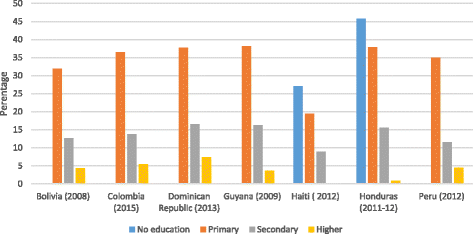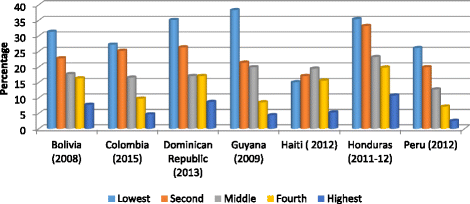Looking back and moving forward: can we accelerate progress on adolescent pregnancy in the Americas?
- PMID: 28705166
- PMCID: PMC5512880
- DOI: 10.1186/s12978-017-0345-y
Looking back and moving forward: can we accelerate progress on adolescent pregnancy in the Americas?
Abstract
Adolescent fertility rates in Latin America and the Caribbean (LAC) remain unacceptably high, especially compared to the region's declining total fertility rates. The Region has experienced the slowest progress of all regions in the world, and shows major differences between countries and between subgroups in countries. In 2013, LAC was also noted as the only region with a rising trend in pregnancies in adolescents younger than 15 years. In response to the lack of progress in the LAC region, PAHO/WHO, UNFPA and UNICEF held a technical consultation with global, regional and country-level stakeholders to take stock of the situation and agree on strategic approaches and priority actions to accelerate progress. The meeting concluded that there is no single portrait of an adolescent mother in LAC and that context and determinants of adolescent pregnancy vary across and within countries. However, lack of knowledge about their sexual and reproductive health and rights, poor access to and inadequate use of contraceptives resulting from restrictive laws and policies, weak programs, social and cultural norms, limited education and income, sexual violence and abuse, and unequal gender relations were identified as key factors contributing to adolescent pregnancy in LAC. The meeting participants highlighted the following seven priority actions to accelerate progress: 1. Make adolescent pregnancy, its drivers and impact, and the most affected groups more visible with disaggregated data, qualitative reports, and stories. 2. Design interventions targeting the most vulnerable groups, ensuring the approaches are adapted to their realities and address their specific challenges. 3. Engage and empower youth to contribute to the design, implementation and monitoring of strategic interventions. 4. Abandon ineffective interventions and invest resources in applying proven ones. 5. Strengthen inter-sectoral collaboration to effectively address the drivers of adolescent pregnancy in LAC. 6. Move from boutique projects to large-scale and sustainable programs. 7. Create an enabling environment for gender equality and adolescent sexual and reproductive health and rights.
Keywords: Adolescent pregnancy; Equity; Latin America and the Caribbean.
Conflict of interest statement
Ethics approval and consent to participate
Not applicable.
Consent for publication
Not applicable.
Competing interests
The authors declare that they have no competing interests.
Publisher’s Note
Springer Nature remains neutral with regard to jurisdictional claims in published maps and institutional affiliations.
Figures
Similar articles
-
The use of long-acting reversible contraceptives in Latin America and the Caribbean: current landscape and recommendations.Hum Reprod Open. 2018 Jan 23;2018(1):hox030. doi: 10.1093/hropen/hox030. eCollection 2018. Hum Reprod Open. 2018. PMID: 30895242 Free PMC article.
-
The Every Woman Every Child initiative: supporting countries in Latin America and the Caribbean to reduce social inequalities in health.Int J Equity Health. 2022 Jun 14;21(1):83. doi: 10.1186/s12939-022-01682-9. Int J Equity Health. 2022. PMID: 35701816 Free PMC article.
-
Barriers to advancing the sexual and reproductive health agenda in Latin America: a qualitative study of key informants' perspectives.Reprod Health. 2024 Dec 18;21(1):187. doi: 10.1186/s12978-024-01927-6. Reprod Health. 2024. PMID: 39696444 Free PMC article.
-
The 2023 Latin America report of the Lancet Countdown on health and climate change: the imperative for health-centred climate-resilient development.Lancet Reg Health Am. 2024 Apr 23;33:100746. doi: 10.1016/j.lana.2024.100746. eCollection 2024 May. Lancet Reg Health Am. 2024. PMID: 38800647 Free PMC article. Review.
-
Access to sexual and reproductive health services for women living with HIV in Latin America and the Caribbean: systematic review of the literature.J Int AIDS Soc. 2019 Apr;22(4):e25273. doi: 10.1002/jia2.25273. J Int AIDS Soc. 2019. PMID: 30958638 Free PMC article.
Cited by
-
Contraceptive use in Latin America and the Caribbean with a focus on long-acting reversible contraceptives: prevalence and inequalities in 23 countries.Lancet Glob Health. 2019 Feb;7(2):e227-e235. doi: 10.1016/S2214-109X(18)30481-9. Lancet Glob Health. 2019. PMID: 30683240 Free PMC article.
-
"I Matter, I Learn, I Decide": An Impact Evaluation on Knowledge, Attitudes, and Rights to Prevent Adolescent Pregnancy.J Prim Prev. 2021 Aug;42(4):343-361. doi: 10.1007/s10935-020-00609-w. Epub 2020 Oct 9. J Prim Prev. 2021. PMID: 33033907
-
Good prenatal care practices in teenage pregnancy from the perspective of healthcare professionals.Rev Colomb Obstet Ginecol. 2021 Sep 30;72(3):244-257. doi: 10.18597/rcog.3695. Rev Colomb Obstet Ginecol. 2021. PMID: 34851568 Free PMC article. English, Spanish.
-
Analysing the context and characteristics of legal abortion and comprehensive post-abortion care among adolescents aged 10-14 in a network of sentinel centres in Latin America: a retrospective cross-sectional study, 2016-2020.Sex Reprod Health Matters. 2023 Dec;31(1):2175442. doi: 10.1080/26410397.2023.2175442. Sex Reprod Health Matters. 2023. PMID: 36919908 Free PMC article.
-
Prevalence of teenage pregnancy and its associated factors in high fertility sub-Saharan Africa countries: a multilevel analysis.BMC Womens Health. 2023 Jan 17;23(1):23. doi: 10.1186/s12905-023-02169-7. BMC Womens Health. 2023. PMID: 36650514 Free PMC article.
References
-
- WHO . WHO guidelines on preventing early pregnancy and poor reproductive outcomes among adolescents in developing countries. Geneva: World Health Organization; 2011. - PubMed
-
- Darroch JE, et al. Adding it up: cost and benefits of meeting the contraceptive needs of adolescents. New York: Guttmacher Institute; 2016. https://www.guttmacher.org/sites/default/files/report_pdf/adding-it-up-a....
-
- UNFPA . The state of world population 2013: motherhood in childhood. New York: United Nations Population Fund; 2013.
-
- UNFPA . Adolescent pregnancy: a review of the evidence. New York: United Nations Population Fund; 2013.
-
- World Bank . Teenage pregnancy and opportunities in Latin America and the Caribbean. On early childbearing, poverty and economic achievement. Washington DC: World Bank; 2012.
MeSH terms
Grants and funding
LinkOut - more resources
Full Text Sources
Other Literature Sources
Medical



